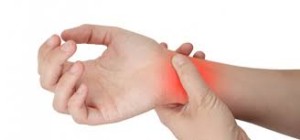 Gout is an acute arthritic condition caused by an increase of uric acid in the blood. This results in urate crystals forming in one or two joints, often in the lower extremity and commonly in the big toe. The pain comes on suddenly, causing intense pain, stiffness, and swelling. Unless it is treated correctly the condition will continue to recur until it becomes chronic.
Gout is an acute arthritic condition caused by an increase of uric acid in the blood. This results in urate crystals forming in one or two joints, often in the lower extremity and commonly in the big toe. The pain comes on suddenly, causing intense pain, stiffness, and swelling. Unless it is treated correctly the condition will continue to recur until it becomes chronic.
The most common sign is night time attack of swelling, tenderness and sharp pain. Gout can also attack the foot, ankle or knees and can last weeks when not treated correctly. Sometimes called gouty arthritis, it is suspected when the patient reports a history of painful arthritis at the base of the toes. Often one joint is only affected while other systemic arthritic conditions such as lupus and rheumatoid arthritis will attack multiple joints simultaneously. (1)
 The most reliable test is to find uric acid crystals in the joint fluid. This means the doctor will use arthrocentesis, or a joint aspiration, to pull out fluid from the affected joint. It is a common office practice performed under local anesthesia. The fluid is sent to the lab for viewing under a polarized microscope. Sometimes when patients have a classic history and symptoms, they will be treated and presumed to have Gout without having an arthrocentesis. But a firm diagnosis is preferable since other conditions can mimic Gout, such as pseudogout, psoriatic arthritis, rheumatoid arthritis and an infected joint.
The most reliable test is to find uric acid crystals in the joint fluid. This means the doctor will use arthrocentesis, or a joint aspiration, to pull out fluid from the affected joint. It is a common office practice performed under local anesthesia. The fluid is sent to the lab for viewing under a polarized microscope. Sometimes when patients have a classic history and symptoms, they will be treated and presumed to have Gout without having an arthrocentesis. But a firm diagnosis is preferable since other conditions can mimic Gout, such as pseudogout, psoriatic arthritis, rheumatoid arthritis and an infected joint.
Gout has four distinct stages of the condition. In the initial stage the individual has no symptoms but there is a build up of uric acid in the blood stream. During the acute phase an individual has complaints of pain, swelling and soreness in a joint. Intercritical stage occurs between flare-ups of Gout. In the chronic stage is when the crystals are deposited in the tendons and ligaments of the joints, the skin becomes swollen and seeps white pus. The goal of treatment is to prevent a chronic stage of the disease.
| Advertisement | |
 |
|



Leave a Reply